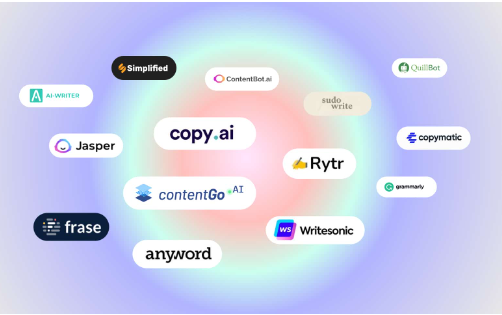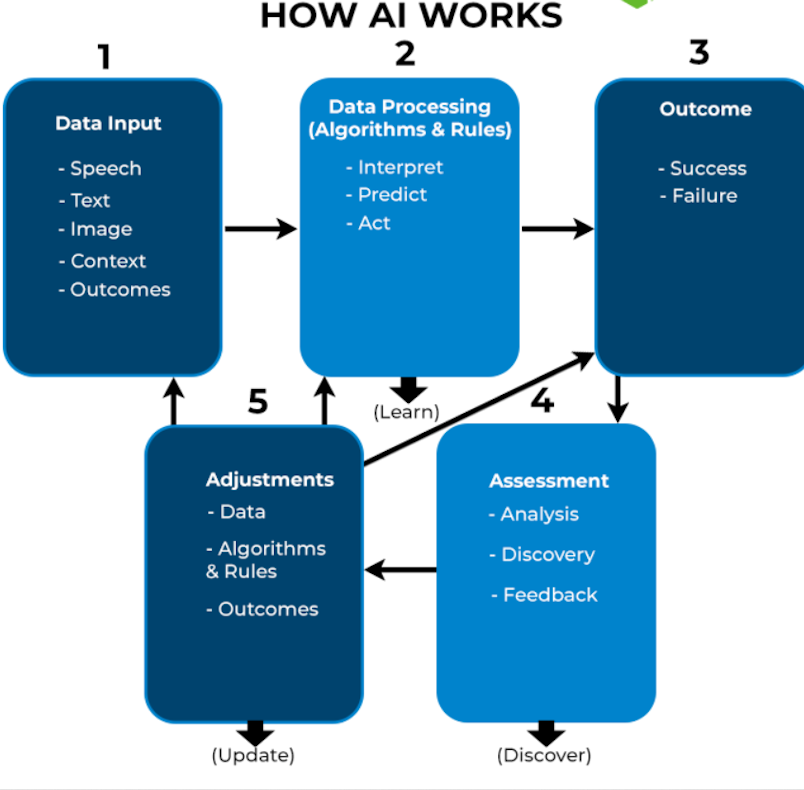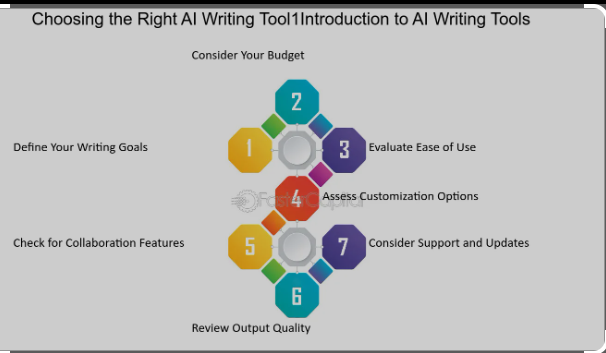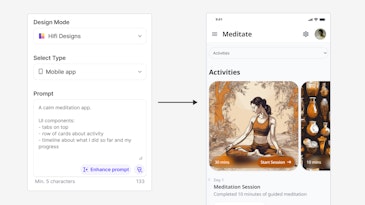Have you ever wanted to write something and felt overwhelmed by the blinking cursor on the blank screen?
Now, would you like to turn the daunting writing task into a fun experience? If you answered "Yes", in your mind, you are now in the world of AI writing tools, a revolutionary solution that makes it easier to master the art of creating content.
AI writing tools aren't just software. They are revolutionizing the way we write today. Artificial intelligence takes your mere ideas or thoughts and transforms them into polished content. Whether you're blogging, creating strategies for marketing content or creating complex narratives, these tools are created to eliminate writer's block and turn you into an overnight "wordsmith".
To get a deeper understanding of how AI is changing the landscape of writing this past article asks the thought-provoking question Will AI replace humans? The article explains the way these tools are created to improve user experience and help writers write compelling content easily.
Let's look at the capabilities offered by AI tools for writers, the way they work and the numerous ways they can help improve your writing.

Understanding 7 Different Types of AI Writing Tools
In a world teeming with information and the constant pressure to produce content rapidly, AI writing tools emerge as the lighthouse for writers navigating the stormy seas of deadlines and creativity blocks. But what exactly are these tools, and how do they work to make the life of a writer less daunting and more productive?
Definition and How They Work:
At their core, AI writing tools are advanced software applications that use artificial intelligence, particularly natural language processing NLP and machine learning ML, to generate text based on user inputs.
AI writing tools have diversified significantly, catering to various aspects of the writing process. Below is an elaboration on the specific functionalities of these tools, complete with examples to illustrate how each category can be effectively utilized:
1. Content Generators:
Blog Post and Article Creators: Tools like Jasper and ContentBot automates the creation of blog posts and articles, using AI to craft content that aligns with specified themes and keywords.
Creative Writing Aids: Sudowrite and ShortlyAI offer features like plot suggestions, character development prompts, and stylistic advice, supporting writers in their creative endeavors.
2. Grammar and Style Checkers:
Syntax and Grammar Correction: Grammarly and ProWritingAid are renowned for detecting and correcting grammar and syntax errors, thus enhancing the text’s readability.
Style Enhancement: The Hemingway App provides feedback on sentence structure, readability, and passive voice usage, guiding writers towards a clearer, more direct style of writing.
3. Idea and Prompt Generators:
Concept Development: Copy.ai generates creative prompts and content ideas, helping marketers and content creators brainstorm new topics effectively.
Research Question Generators: Scalenut offers tools to aid academic and technical writers in formulating research questions and outlining papers, based on the latest data and trends.

4. Summarization Tools:
Executive Summary Creators: SummarizeBot can distill long business reports and documents into concise summaries, saving time for professionals who need quick insights.
Academic Abstract Generators: Scholarly helps scholars by synthesizing key elements of research papers into brief, informative abstracts.
5. Translation Tools:
Multi-language Translation: DeepL offers high-quality translations that maintain the nuances of the original text, making it invaluable for writers looking to reach an international audience.
Localization Tools: Smartling provides localization services that adapt content not only linguistically but also culturally, ensuring that the material resonates with the target demographic.
6. SEO Optimization Tools:
Keyword Integration: SEMRush and Yoast SEO guide users in strategically placing keywords throughout their content to optimize search engine visibility without compromising the natural flow of writing.
SEO Performance Analysis: Ahrefs analyzes the potential performance of content in search rankings and offers detailed feedback for optimization according to SEO best practices.
7. Text-to-Speech and Speech-to-Text Tools:
Dictation Tools: Dragon Naturally Speaking provides robust speech-to-text capabilities, allowing writers to dictate their content, which the AI then transcribes.
Audio and Podcast Scripts: Descript converts written content into scripts suited for audiobooks and podcasts, enabling content creators to expand their reach into audio formats.
In the realm of AI and creativity, the AI Startups page offers a glimpse into the innovative world of AI applications beyond writing. It showcases how AI's versatility is being tapped across different sectors, including those developing the next generation of AI writing aids.
The Power Behind AI Writing Tools: Features and Capabilities
AI writing tools are not just about replacing the traditional writing process; they enhance and transform it. These tools leverage advanced algorithms and machine learning techniques to offer a suite of features that can significantly improve any writing task's efficiency, creativity, and accuracy. Here's a closer look at the primary capabilities of these powerful tools:
Automation and Efficiency:
AI writing tools are designed to automate repetitive tasks within the writing process, freeing up time for writers to focus on more creative aspects. For instance, content generation tools can produce draft articles within minutes, which writers can then refine and personalize. Example: Articoolo and Zyro create complete drafts based on a few input keywords, dramatically speeding up the content creation process. Learn how AI can streamline your writing process by reading about automation and efficiency in writing.
Enhanced Creativity:
One of the standout features of AI writing tools is their ability to enhance creativity. These tools can suggest novel ideas, diverse vocabulary, and different writing styles, helping writers break free from creative ruts and explore new perspectives and approaches in their writing. Example: Rytr uses AI to suggest different content angles and creative twists, providing writers with unique ways to approach their topics.
Accuracy and Polish:
AI writing tools are also invaluable for improving the accuracy and polish of written content. Grammar and style checkers can identify and correct errors that might be overlooked during manual editing. They also suggest stylistic improvements, making the text not only correct but also more engaging and readable. Example: Ginger Software scans text for both grammatical errors and stylistic issues, offering corrections and suggestions to enhance clarity and style.
Collaborative Writing:
These tools facilitate collaboration among teams by allowing multiple users to work on a document simultaneously, track changes, and provide real-time feedback. This is particularly useful in environments where team input is crucial, such as in marketing campaigns or publication articles. Example: Google Docs and Microsoft Editor integrate AI-driven writing assistance to help teams collaborate efficiently, ensuring consistency and quality in shared documents.
SEO Optimization:
In the digital age, visibility is key. AI writing tools equipped with SEO optimization features help ensure that content is not only well-written but also designed to perform well on search engines.
They analyze keywords, suggest optimizations, and even monitor performance to guide content strategy. Example: Clearscope and MarketMuse provide comprehensive SEO insights, helping writers optimize their content for better search engine ranking. Learn more about how AI is revolutionizing fields beyond just writing by exploring AI Tools for Recruiting.
Personalization and Adaptation:
AI tools learn from user interactions, adapting to the writer's style and preferences over time. This makes them more effective as they become more attuned to the specific needs and nuances of the writer’s style. Example: ProwritingAid offers personalized writing reports and suggestions based on the writer’s past work, adapting its advice to suit the writer's evolving style.

AI Writing Tools in Action: Use Cases Across Industries
AI writing tools have broad applications across various industries, revolutionizing how content is created, optimized, and delivered. These tools are not limited to traditional writers or content marketers but extend their utility to businesses, academics, and creative industries. Here's how AI writing tools are making significant impacts across different sectors:
For Writers and Authors:
Writers and authors can leverage AI writing tools to overcome creative blocks, enhance narrative development, and streamline the editing process. AI can provide alternative plot suggestions, and character insights, and even help with world-building, making it easier to craft compelling stories. Example: NovelAI offers storytelling aids that help fiction writers by generating intricate narrative threads and character dialogues, enriching the storytelling experience.
Businesses and Marketing:
In the realm of business and marketing, AI writing tools help create high-impact content quickly. From generating product descriptions to crafting personalized email campaigns, these tools ensure that businesses can produce relevant, engaging content that resonates with their target audience and drives conversions. For insights into how AI tools are being integrated into web applications, see our project on SAAS AI-Based Web App Example: Copysmith excels in generating high-quality marketing copy, from advertisements to product descriptions, tailored to specific audience segments.
Academic and Research Writing:
Academics and researchers benefit from AI writing tools that help in drafting research papers, creating bibliographies, and ensuring that their writing meets the stringent standards of academic publication. These tools can also analyze vast amounts of literature to identify trends and gaps in research. Example: Scite is a tool that assists researchers by providing smart citations and helping identify how a scientific paper has been cited, offering context that is crucial for literature reviews.
Writing Agencies:
Content and writing agencies use AI tools to manage large volumes of content creation for clients across different industries. Example: ContentBot helps agencies by providing AI-powered content creation, from blog posts to full-length articles, ensuring high throughput without compromising on quality.
Educational Content Creation:
Educators and e-learning professionals use AI to create educational materials that are tailored to diverse learning needs. AI tools can summarize key information, generate quiz questions, and even adapt content based on the learner's progress. Example: Quizlet utilizes AI to create customized learning sets that adapt to the individual's learning pace and style, enhancing engagement and retention.
Legal and Compliance Documentation:
In legal sectors, AI writing tools help draft and review compliance documents and contracts, ensuring they meet all legal standards and are up to date with current laws and regulations. This reduces the burden on legal teams and minimizes the risk of errors.
Example: ROSS Intelligence uses AI to streamline legal research, draft legal documents, and ensure compliance with the latest legal standards.
The versatility of AI tools enables them to adapt to the specific demands of each industry, proving that AI's potential in professional writing is vast and transformative.

Selecting an AI Writing Tool: Factors to Keep in Mind
Selecting an AI writing tool can significantly enhance your writing process, whether it's marketing content creation, academic articles, or creative fiction writing. But selecting which tool best meets your needs takes careful consideration of several key factors - here are the essential criteria to help select an effective AI writing tool:
1. Consider Functionality:
Determine what specific writing tasks need assistance: do you need help in terms of brainstorming ideas, grammar checks, or SEO optimization? Different tools specialize in different aspects of writing; make sure the one chosen meets all your primary requirements. To make an informed decision, consider selecting the right AI writing tool, which offers detailed comparisons and recommendations.
2. Ease of Use: Your tool should have an intuitive interface that you can navigate quickly. Complex tools may make your work less efficient. Look for tools with clear instructions and accessible support services.
3. Integration Capabilities: Take note of whether an AI writing tool integrates well with other programs you utilize regularly, such as word processors or content management systems - some plugins exist that could improve workflow efficiency by making use of AI writing tools easier.
4. Cost and Benefit Analysis:
Pricing Structure: Investigate different tool's pricing models carefully. Some provide subscription-based access while others have either one-time purchase prices or pay-per-use models; compare costs against features provided to determine if your investment will result in productivity gains.
Free Trials and Demos: Before making your purchase decision, check whether the tool offers a free trial or demo version so that you can test its capabilities without making a financial commitment.
5. User Experience and Support:
Read Customer Reviews and Feedback: Explore what other users are saying about the tool in terms of reliability, customer service, and practical application. This feedback may offer insight into its quality of construction or use.
Customer Support: To maximize the experience with any tool, ensure adequate customer support is readily available. Experienced support staff can quickly resolve issues quickly while offering helpful guidance - adding greatly to overall user satisfaction with the tool.
Scalability: Determine whether the tool can scale with your needs as your writing or business demands increase without suffering a degradation in performance.
Updates and Improvements: When choosing tools, regularly scheduled updates not only fix bugs but also enhance features while remaining compatible with evolving technology standards.
6. Security and Privacy:
Data Security: Check the tool's security features carefully if you will be dealing with sensitive data, in particular understanding where it will be stored, who has access to it, and any precautionary measures in place for protecting it.
Compliance: Make sure the tool you are using complies with relevant laws and regulations, particularly regarding data protection. Doing this is critical to avoid legal complications and maintain your good name and reputation.
By considering these factors, you can make an informed decision to select an artificial intelligence writing tool that not only enhances your writing process but also fits with operational needs and budget constraints.

Future of Writing: AI Writing Tools’ Impact and Evolution
As we look to the future, the impact of these AI writing tools is expected to grow, bringing both advancements and challenges to the field of writing. Here’s a glimpse into the potential future developments and considerations surrounding AI writing tools:
Innovations on the Horizon:
Enhanced Natural Language Understanding: Future AI writing tools are likely to exhibit a more sophisticated understanding of human language nuances, including regional dialects and industry-specific jargon. This will enable even more accurate and contextually appropriate content generation.
Voice-Activated Writing Assistance: As voice technology continues to advance, AI writing tools might evolve to offer more robust voice-command features, allowing users to dictate content and receive verbal feedback from the AI, enhancing accessibility and multitasking.
Interactive and Predictive Writing: AI tools could become more interactive, offering real-time suggestions and predictions based on the user’s writing habits and preferences.
Ethical Considerations and Authorship
a. Authorship and Originality: As AI tools become capable of producing large volumes of high-quality content, questions about authorship and originality will become more pressing. Delve into the ethical considerations and authorship associated with AI writing tools to navigate these complex issues
b. Bias and Fairness: AI writing tools rely on data to learn and make decisions. Ensuring these tools are free from biases present in their training data is crucial to avoid perpetuating stereotypes or inaccuracies in AI-generated content.
c. Transparency in AI Contributions: There may be a need for greater transparency regarding the extent of AI involvement in published content. This could involve disclosures about how much content is AI-generated versus human-edited, maintaining trust and integrity in professional writing.
Impact on Employment and Skills:
a. Job Transformation: AI writing tools are likely to transform writing jobs rather than replace them. Writers may need to develop new skills to work alongside AI effectively, such as data analysis and AI tool management.
b. Education and Training: Educational institutions might start offering more courses on digital literacy and AI tool usage, preparing the next generation of writers for a workplace where AI tools are common.
c. Expansion of Capabilities: With AI handling more routine aspects of writing, human writers could focus on tasks that require deep creativity, critical thinking, and emotional intelligence. This could lead to new genres and styles of writing that blend human creativity with AI efficiency. For a deeper understanding of AI's impact on design and user experience, explore the AI UX Research Trend article.
Legal and Regulatory Frameworks:
Intellectual Property Rights: The rise of AI in writing will necessitate clear guidelines on intellectual property rights concerning AI-generated content. Who owns the content, how it can be used, and the rights of the AI versus the human operator will need to be legally defined.
Data Privacy Regulations: As AI writing tools handle more sensitive information, adherence to data privacy laws will be critical. Ensuring that AI tools comply with regulations like GDPR and CCPA will be essential for their widespread adoption.
The future of AI writing tools holds exciting possibilities for enhancing writing processes, improving content quality, and making writing more accessible to a broader audience.
Conclusion: Embracing AI for Enhanced Writing
As we have explored the capabilities, applications, and future implications of AI writing tools, it is clear that these technologies offer transformative potential for writers across all disciplines. By automating routine tasks, enhancing creativity, and ensuring high standards of grammatical precision, AI writing tools are redefining the boundaries of what is possible in the realm of writing.
Embracing the Change:
Adopting AI writing tools means embracing change and recognizing the value these tools bring to both individual writers and the broader writing industry. For writers, AI tools can be seen as a supportive partner that offers assistance with brainstorming, drafting, editing, and refining content. Master the capabilities of AI writing tools and transform your content strategy with our guide at ChatGPT Mastery
Leveraging AI for Competitive Advantage:
In the competitive world of content creation, those who leverage AI effectively will find themselves at an advantage. By integrating AI writing tools, content creators can produce more relevant, engaging, and targeted writing in less time.
See how AI is shaping the future of user interface design at our AI Design Agency. This efficiency allows writers and businesses to stay ahead of trends, respond quickly to market changes, and maintain a strong online presence.
Stay updated on future advancements in AI writing technology to understand how these changes will affect the writing landscape.

